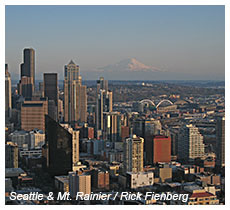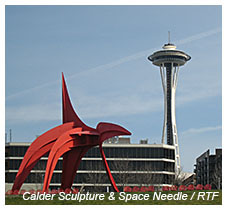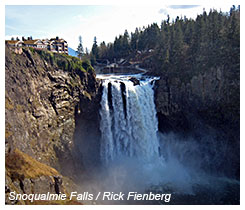Coffee Meets Cosmos in the Great Pacific Northwest

Richard Fienberg Running Hare Observatory
Grab your coffee mug and make your travel plans for the 225th AAS meeting, when the Society returns to Seattle, Washington, as it does every fourth winter. The conference takes place 4-8 January 2015 at the Washington State Convention Center, conveniently located downtown and a great jumping-off point for excursions to picturesque Puget Sound and the magnificent Cascade Range, home to towering Mount Rainier and several fine ski resorts. Gathering with the AAS in January are its Historical Astronomy Division (HAD) and High Energy Astrophysics Division (HEAD). Meeting sponsors include Universities Space Research Association (USRA), Apogee Imaging Systems, Associated Universities, Inc., Ball Aerospace & Technologies Corp., Spectral Instruments, Inc., W. W. Norton, and the Space Science Institute. Twitter hashtag: #aas225.
The Seattle meeting offers a rich assortment of prize and invited talks by some of our most distinguished colleagues. We’ll kick off on Monday morning with the Kavli Foundation Lecture by Daniel Baker (University of Colorado, Boulder), who will review recent progress toward understanding the Earth-girdling Van Allen radiation belts. Emily Levesque (also UC-Boulder) will give the Cannon Award lecture on her innovative work using gamma-ray bursts to explore fundamental questions of stellar astrophysics and cosmology. Sagan Fellow Katja Poppenhaeger (Harvard-Smithsonian Center for Astrophysics) will explore the high-energy environment of exoplanets. Douglas Finkbeiner (Harvard-Smithsonian Center for Astrophysics), Tracy Slatyer (MIT), and Meng Su (MIT) will jointly present the HEAD Rossi Prize lecture on their discovery, in gamma rays, of the “Fermi bubbles” and on subsequent studies of these unanticipated galactic structures at other wavelengths.
Piero Madau (University of California, Santa Cruz), recipient of this year’s Dannie Heineman Prize for Astrophysics, awarded jointly with the American Institute of Physics, will describe highlights of his research on the era of first light in the universe, the ionization and heating of the intergalactic medium, and the formation and evolution of galaxies. Fiona Harrison (Caltech) will present results from NASA’s ongoing Nuclear Spectroscopic Telescope Array (NuSTAR) mission, the first to capture images of the hard-X-ray sky. By special arrangement with the Royal Astronomical Society (RAS) in the United Kingdom, Carlos Frenk (University of Durham) will give his RAS Gold Medal lecture on the status of the cold dark matter paradigm in light of recent computer simulations and redshift surveys. And four years after the first recipient of the Berkeley Prize gave the final plenary presentation at the last Seattle meeting, David Weinberg (Ohio State University) will wrap up the 225th meeting’s science program with his Berkeley Prize lecture on the Sloan Digital Sky Survey’s remarkable contributions to astrophysics.
The Society is committed to astronomers’ professional development in areas beyond pure science, and this is amply reflected in the Seattle meeting program. A Sunday-afternoon workshop focuses on leadership, project management, and teambuilding. Monday evening features a career networking reception and job fair, and on Tuesday afternoon the AAS Committee on Employment convenes a special session and panel discussion on careers in the tech industry. The AAS Committee on the Status of Women in Astronomy (CSWA), Committee on the Status of Minorities in Astronomy (CSMA), and Working Group on LGBTIQ Equality (WGLE) are jointly presenting a Wednesday-evening session on understanding, discussing, and overcoming “Imposter Syndrome.”If you teach Astro 101 and haven’t yet taken the teaching-excellence workshop put on by the University of Arizona’s Center for Astronomy Education (CAE), you’ll have a chance to do so on Saturday and Sunday, January 3rd and 4th. Still more workshops are being offered that same weekend, including a joint AAS/NRAO science-communication/media-training workshop, the third annual AAS Astronomy Ambassadors workshop on resources and techniques for effective outreach to students and the public (application deadline: 20 October 2014), and a variety of tutorials on topics such as databases, astrostatistics, tools for online collaboration, and how to build, use, validate, and share software.
The HAD meeting gets under way Sunday afternoon with two sessions: “Astronomy and the First World War” and “Ideas of Evolution Inside and Outside of Astronomy During the Long 19th Century.” These will be followed by the undergraduate orientation, which attracts an impressive horde of college students interested in learning about their options for summer internships and graduate school in astronomy, and the opening reception, where you can reunite with friends and colleagues, share a laugh over a drink (perhaps something a bit harder than coffee), and eat your fill from our lavish buffet.
HAD sessions continue on Monday, with a special session entitled “Preserving the Material Legacy of the American Observatory Movement.” HEAD convenes two special sessions that day as well, taking stock of the past, present, and future of general relativity on the occasion of its centennial. Other special sessions include “Astronomy Across Africa,” “Results from the SDSS-III/APOGEE Survey II,” and “Science with the 3D-HST Survey.” There will also be a wide variety of contributed oral and poster presentations, bringing the total number of plenaries, short orals, and posters to somewhere north of 1,000.In addition to all that, the Seattle program is chock-full of Town Hall meetings on astronomy and public policy. You’ll have opportunities to hear from, and provide feedback to, representatives from NASA and the National Science Foundation. The directors of the National Optical Astronomy Observatory and National Radio Astronomy Observatory will provide updates on their respective facilities and programs. Our current and future flagship orbiting observatories — the Hubble Space Telescope and the James Webb Space Telescope — will both be the subjects of Town Hall discussions. And the AAS Committee on Astronomy and Public Policy will hold a Town Hall on science policy and advocacy.
The inaugural AAS Open Mic Night in Washington, DC, last January was a huge success, so we are bringing it back for Seattle. The Tuesday-evening spectacle features members sharing their musical, magical, comedic, and other talents with friends and colleagues. It’s not a competition — just a chance to have some fun and strut your stuff (to sign up, use our online form). Cocktails, wine, and beer will be available for purchase at the show.
With so much going on at the meeting, you may have trouble finding time to get out and explore Seattle, so you should consider coming early and/or staying late. Seattle is one of the most attractive and most livable cities in the country, with a huge number of attractions appealing to every taste. Highlights include Pike Place Market with the original Starbucks, the Space Needle, the Pacific Science Center, the Museum of Flight, the Seattle Art Museum and Olympic Sculpture Park, Snoqualmie Falls, Chihuly Garden and Glass — the list goes on and on. So if you find yourself sleepless in Seattle, at least you know there will always be something interesting to do.We hope you’ll join us in Seattle. Note that the abstract-submission deadlines are 1 October (regular) and 2 December (late), while the registration deadlines are 13 November (regular) and 18 December (late). Special hotel rates are guaranteed only through 12 December. Of course, you can always decide to show up at the last minute, but you’ll save money by planning ahead. Check the meeting page and online science program for more information as it becomes available.





